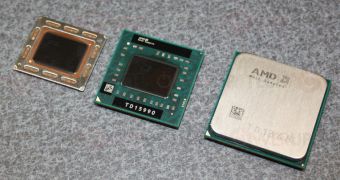AMD has yet again changed its performance estimates for its next-gen Trinity APUs, the company now expecting these chips to be 29 percent faster in productivity apps than their current counterparts based on the Llano architecture.
This new performance forecast showed up on a company slide recently published online by Tom’s Hardware.
AMD doesn’t say what sort of applications or which APUs were used to test the performance of the two architectures, but the footnotes do mention that the data presented in the slides is based on internal company projections.
A part of the speed increase mentioned by AMD in its document is expected to be made possible by the introduction of a faster graphics core.
According to the same AMD slide, Trinity accelerated processing units can deliver up to 56 percent better visual performance than Llano.
At the same time, the chips will be optimized for Windows 8 and include the 3.0 version of the company’s Turbo Core technology.
AMD's next-generation APUs combine processing cores based on the Bulldozer architecture with a VLIW4 GPU derived from the Cayman graphics used inside the Radeon HD 6900 series.
These cores will go by the name of Piledriver and will support a series of new instruction sets introduced with the Bulldozer architecture, such as AVX and AES-NI, as well as DDR3-2133 memory.
On the graphics side, AMD has added a series of new HD media accelerator technologies to its chips, such as a Video Compression Engine, and support for its multi-monitor EyeFinity configurations.
Notebooks configured with the mobile version of the Trinity APUs should be capable of reaching “more than 12 hours of resting battery life,” according to AMD.
AMD’s first APUs, based on the Trinity architecture, are rumored to be launched in June or July this year.

 14 DAY TRIAL //
14 DAY TRIAL // 
